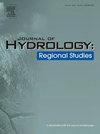Hydro-chemical tracers and hydro-chemical modeling assessing groundwater leakage for a karst aquifer in Yarkon-Taninim basin, Israel
IF 4.7
2区 地球科学
Q1 WATER RESOURCES
引用次数: 0
Abstract
Study region
Yarkon-Taninim groundwater basin, Israel.
Study focus
A Paleocene-Eocene thermal episode caused an anomaly of barium and silica concentrations in the Eocene aquitard that were used as natural tracers for identifying and quantifying leakage into the Turonian – Upper Cenomanian aquifer through the Senonian-Paleocene (Mount-Scopus Group) strata. Increased concentrations of both Ba2+ and SiO2 in Turonian – Upper Cenomanian aquifer groundwater were supposed to be a sign of downward leakage from the Eocene aquitard. Within the Menashe syncline where these tracers pointed to the leakage, it was estimated by the balance method. Using this estimate, the area-averaged hydraulic conductivity of the intermedium layer was assessed from the Darcy’s law by using this layer thickness and a hydraulic gradient between the Avdat-Group aquitard and the Turonian – Upper Cenomanian aquifer. The calculation and integration of its results over the balance area by a grid with 1×1 km2 cells was performed by using the GIS-based ARGUS ONE software. Cl- and SO42- concentrations in the leakage have been estimated by using the mixing model considering the assessed leakage. PHREEQC software was used for solubility calculation of amorphous silica, quartz and barite at different temperatures, pH and salinities and for calculation of saturation indices of Ba-bearing minerals.
New hydrological insights for the region
Previously the Senonian layers within synclines in the Yarkon-Taninim basin, which is the primary source of the groundwater supply in Israel, were supposed to be impermeable. This study has shown that the main leakage is concentrated in the Menashe syncline vicinity north of the Yarkon-Taninim basin. The two tracers first provided a possibility of the leakage assessment within the Menashe syncline: more than 2.3*106 – 11.4*106 m3 yr−1 (leakage rate of 5.4*10−5 – 2.6*10−4 m day−1 at the Eocene outcrops of the syncline). The average regional permeability of the Senonian aquiclude within the Menashe syncline was estimated in the range 7.7*10−5 – 3.8*10−4 m day−1, essentially higher as compared to the values for the Bet-Govrin syncline. The salinity of the slow leakage was assessed to be low; therefore, it will not damage the high-quality groundwater in the Turonian – Upper Cenomanian aquifer that is exploited for the potable water supply.
水化学示踪剂和水化学模型评估以色列亚尔康-塔尼尼姆盆地岩溶含水层的地下水渗漏情况
研究重点 古新世-始新世的热事件导致始新世含水层中的钡和二氧化硅浓度异常,这些钡和二氧化硅被用作天然示踪剂,用于确定和量化通过塞诺尼-古新世(斯科普斯山组)地层渗漏到图伦纪-上新世含水层的情况。都龙纪-上新统含水层地下水中 Ba2+ 和 SiO2 浓度的增加,被认为是始新世含水层向下渗漏的迹象。在这些示踪剂表明存在渗漏的梅纳谢突岩中,用平衡法对渗漏进行了估算。根据这一估算结果,利用中间层厚度和阿夫达特组含水层与都伦-上新统含水层之间的水力梯度,根据达西定律评估了中间层的区域平均水力传导率。利用基于地理信息系统的 ARGUS ONE 软件,通过 1×1 平方公里的网格对平衡区进行了计算和整合。考虑到评估的泄漏量,使用混合模型估算了泄漏中的 Cl- 和 SO42- 浓度。PHREEQC 软件用于计算无定形二氧化硅、石英和重晶石在不同温度、pH 值和盐度下的溶解度,以及计算含钡矿物的饱和指数。这项研究表明,主要的渗漏集中在亚尔康-塔尼尼姆盆地北部的梅纳谢突岩附近。两种示踪剂首先提供了对梅纳谢突岩内部渗漏评估的可能性:超过 2.3*106 - 11.4*106 立方米/年-1(在突岩的始新世露头处,渗漏率为 5.4*10-5 - 2.6*10-4 米/天-1)。据估计,梅纳谢向斜内的塞诺尼安含水层的平均区域渗透率为 7.7*10-5 - 3.8*10-4 米/天-1,基本上高于 Bet-Govrin 向斜的数值。经评估,缓慢渗漏的盐度较低;因此,它不会对用于饮用水供应的图伦纪--上塞努曼纪含水层中的优质地下水造成损害。
本文章由计算机程序翻译,如有差异,请以英文原文为准。
求助全文
约1分钟内获得全文
求助全文
来源期刊

Journal of Hydrology-Regional Studies
Earth and Planetary Sciences-Earth and Planetary Sciences (miscellaneous)
CiteScore
6.70
自引率
8.50%
发文量
284
审稿时长
60 days
期刊介绍:
Journal of Hydrology: Regional Studies publishes original research papers enhancing the science of hydrology and aiming at region-specific problems, past and future conditions, analysis, review and solutions. The journal particularly welcomes research papers that deliver new insights into region-specific hydrological processes and responses to changing conditions, as well as contributions that incorporate interdisciplinarity and translational science.
 求助内容:
求助内容: 应助结果提醒方式:
应助结果提醒方式:


